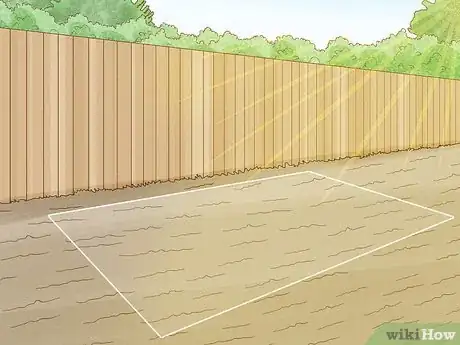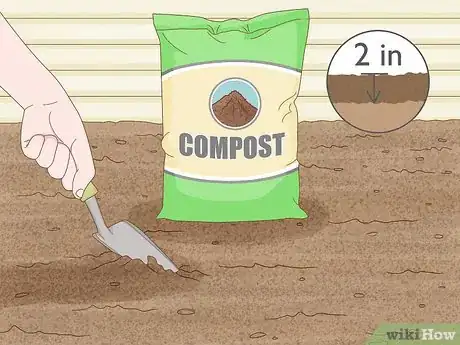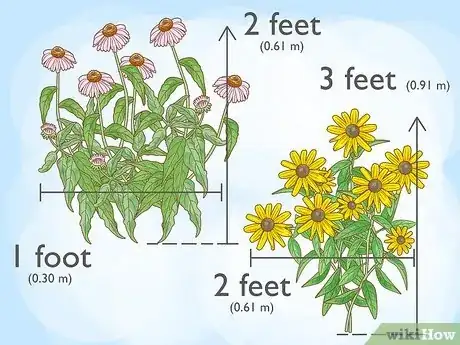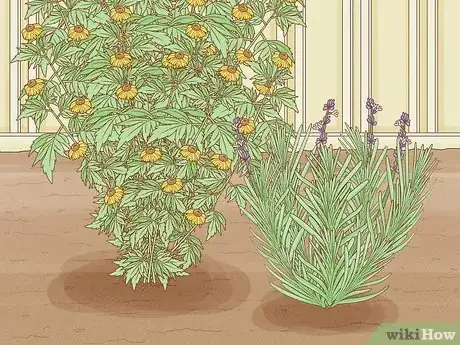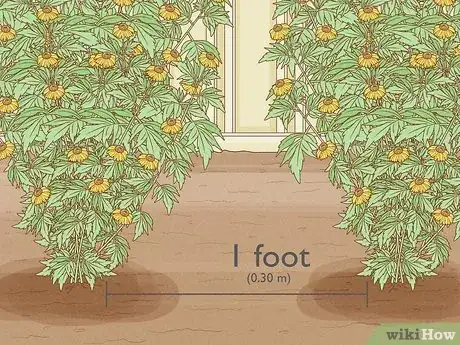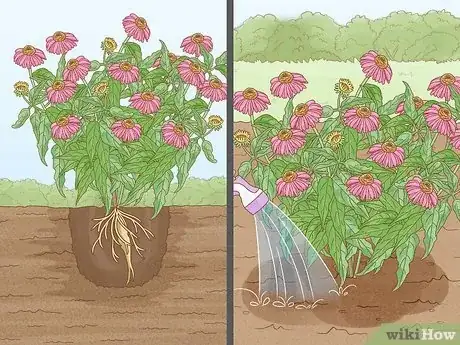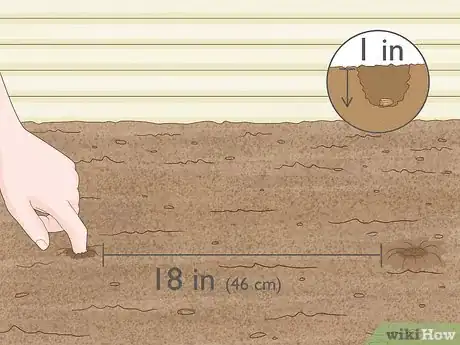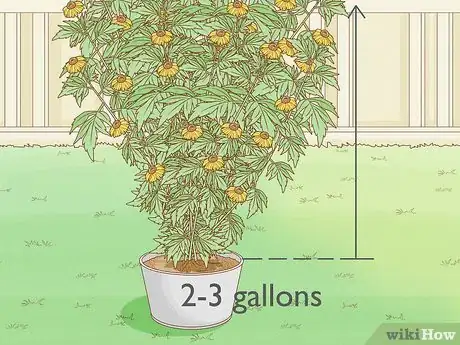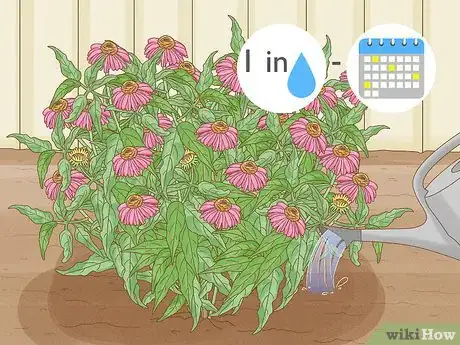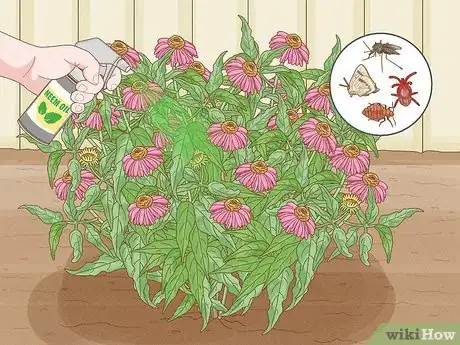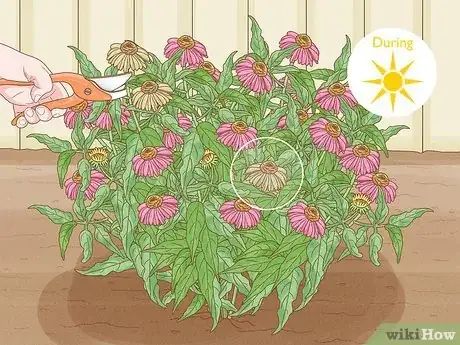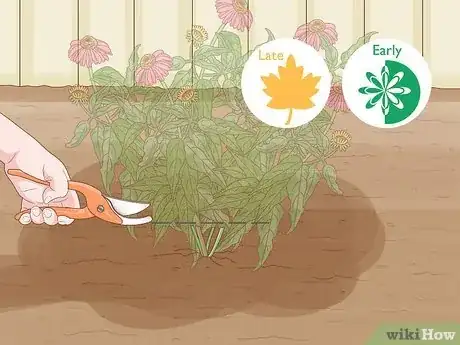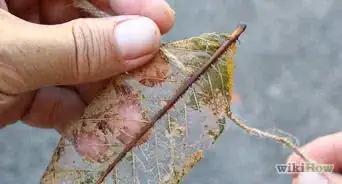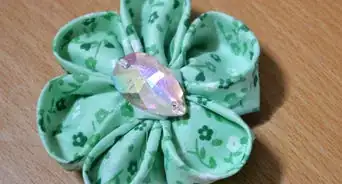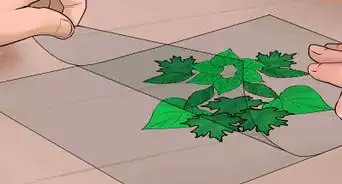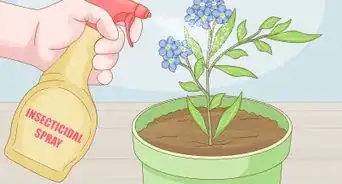This article was co-authored by Monique Capanelli and by wikiHow staff writer, Glenn Carreau. Monique Capanelli is a Plant Specialist and the Owner and Designer for Articulture Designs, an innovative design firm and boutique in Austin, Texas. With over 15 years of experience, Monique specializes in interior botanical design, living walls, event decor, and sustainable landscape design. She attended the University of Texas at Austin. Monique is a Certified Permaculture Designer. She provides plant and botanical design experiences, from small gifts to entire transformations, to shoppers as well as commercial clients including Whole Foods Market and The Four Seasons.
There are 11 references cited in this article, which can be found at the bottom of the page.
This article has been viewed 17,873 times.
Colorful, striking, and extremely hardy, coneflowers (Echinacea) are the perfect summer perennial for your garden. They're easy to care for regardless of your experience level and attract helpful pollinators like bees, hummingbirds, and butterflies. If you're wondering how to grow this vibrant wildflower in your garden, you've come to the right place! Our complete guide will show you everything you need to know about coneflower planting, growth, and care.
Steps
Creating the Right Conditions for Coneflowers
-
1Plant your coneflowers in the spring.[1] It's safe to plant coneflowers once the danger of frost has fully passed, but they can be cultivated throughout the rest of spring and early summer as well. Coneflowers enjoy a long flowering season, typically blooming from mid-summer into the fall.
- Seeds can be started inside the house 6 to 8 weeks before the last spring frost or outside once the soil has warmed to around 70 °F (21 °C) (usually in the spring).[2]
- If you're dividing or transplanting existing coneflowers in your garden, do it in the spring or fall.
-
2Pick a spot that offers full sun. Coneflowers are happiest when they have access to direct sunlight for 6 to 8 hours each day. Because they're heat resistant, you won't have to worry about them getting damaged or dried out in the sun. However, coneflowers can also tolerate light shade if necessary.[3]
- If they get too much shade, your coneflowers will be vulnerable to powdery mildew, and you'll notice they have droopy stems.
Advertisement -
3Make sure the garden has well-drained soil and compost. Coneflowers do best with well-drained (not overly wet) soil rich in organic matter. Once you’ve picked an ideal spot, loosen the soil with a garden fork and mix in a 2 inches (5.1 cm) to 4 inches (10 cm) layer of compost so your coneflowers have plenty of nutrients.[4]
- To check your soil's drainage, dig a hole that's about 12 inches (30 cm) wide and deep. Fill it with water and let it drain completely before filling the hole again. Monitor the water level this time: if your soil is well-drained, the water level will drop by 1 inch (2.5 cm) every hour.
- Coneflowers are hardy flowers that can flourish in a wide range of conditions, so it's okay if your soil isn't perfect. Plus, adding compost improves your soil's drainage.
-
4Select a type of coneflower to grow. Purple coneflowers (Echinacea purpurea) are the traditional purple blooms you probably picture when you think of coneflowers. However, hybridized versions of purpurea also come in vibrant red, orange, and pink shades. These large flowers can grow to be 4 feet (1.2 m) tall and 3 feet (0.91 m) wide.[5] Other varieties include:
- Yellow coneflowers (Echinacea paradoxa) are bright blooms that can be grown next to other types of coneflower or grown separately. They grow in multi-stemmed clumps that can be up to 3 feet (0.91 m) tall and 2 feet (0.61 m) wide.
- Narrow-leaved coneflowers (Echinacea angustifolia) work well in small spots. This compact coneflower stays between 1 foot (0.30 m)-2 feet (0.61 m) tall and wide. Its pink petals are paler than those of the purple coneflower.
-
5Place coneflowers next to other perennials. You can create a healthy and colorful garden by pairing coneflowers with plants that attract pollinators and have similar needs. Coneflowers are perennials, which are plants that grow back year after year, so other perennials are easy to grow in the same space.
- Meadow perennials like bee balm, black-eyed susans, lavender, asters, lupines, and larkspur are all great choices to pair with coneflowers.[6]
Planting Coneflowers
-
1Space out the coneflowers to be 1 foot (0.30 m) to 3 feet (0.91 m) apart. Since full-grown coneflower plants will grow quite a bit—anywhere from 2 feet (0.61 m) to 3 feet (0.91 m) wide, and up to 4 feet (1.2 m), it’s important to give them space to grow. Make sure there’s enough room in your garden for all of the coneflowers that you want to plant.[7]
- If space gets tight, consider growing a more compact variety like narrow-leaved coneflowers.
-
2Bury coneflower plants to the top of their roots and water them. Dig a hole big enough for the plant; if the coneflower came in a pot, the hole's width should be twice the pot's diameter. Then, place the plant in the hole, so its root ball is even with the soil surface. Fill in the rest of the soil. When you're done, water the coneflower generously to encourage deep roots.[8]
- Digging such a wide hole is helpful because it gives the coneflower's roots space to spread and grow.
- Immediately after planting and watering the coneflowers, apply a thin layer of mulch and compost over the soil's surface to prevent weeds.
-
3Sow coneflower seeds as an alternative to buying small plants. Place seeds less than 1 inch (2.5 cm) underground—as seeds, coneflowers don't need to be far below the soil's surface. However, seeds need plenty of space to grow, so plant them roughly 18 inches (46 cm) apart from one other.
- Growing coneflowers as plants bought from a nursery is most common, but coneflower seeds are also easy to care for. You can buy them, or collect them from coneflower plants in bloom.
- Remember that seeds collected from coneflower plants will take 2 years of growth before flowering.[9]
-
4Grow coneflowers inside with a 2 gallons (7.6 l) to 3 gallons (11 l) pot. That may seem big for a pot, but your coneflowers will need room to grow! First, spread crushed gravel across the bottom of the pot for drainage. Then, fill the pot about halfway full with potting soil. Place your coneflower inside the pot so that its roots are an inch below the pot's rim, and then fill it in with soil.[10]
- Once you're done planting, water the coneflower just like you would if it was in the ground.
- Make sure that any pot you pick has drainage holes since coneflowers like to live in drier soil.
- The container's material doesn't matter as much as its size. Coneflowers can handle heat, so even metal is fine.
Caring for Coneflowers
-
1Give your coneflowers 1 inch (2.5 cm) of water per week. You likely won't have to water the plants manually during weeks of rain. Keep up with weekly watering during dry spells, applying water directly to the base of the coneflower; top-down watering onto its leaves can cause fungal growth.[11]
- Because they're drought-resistant, coneflowers don't need to be constantly watered. In fact, they may be damaged if their roots get too soaked.
- Hybrid species of coneflowers may need more frequent watering to live healthy lives.
-
2Keep the soil free of weeds. Coneflowers don't compete well for nutrients in the soil, so make sure that weeds aren't growing around your flowers and stealing their food. Check your garden regularly throughout the spring and summer, pulling up weeds by their roots as they grow.[12]
- Apply a thin layer of mulch and compost each spring. This retains moisture and discourages weeds from growing in the area, which will make it easier for you to monitor your coneflowers in the summer.
-
3Spray coneflowers with neem oil to remove pests. Even though coneflowers' spiny stems protect them from deer and other large animals, insects like aphids can still cause problems. Lightly spread neem oil, which can be bought as a spray, onto the surface of your coneflowers. It's an effective and natural insecticide, so it won't hurt your garden.
-
4Deadhead your coneflowers throughout summer and fall. "Deadheading" is snipping a flower that has already bloomed, so it doesn't devote energy to setting seeds—and instead, the plant produces more flowers. When you see flowers start to wither after blooming during the growing season, remove them from the plant. This will prolong the amount of time your coneflower spends flowering as a whole![13]
-
5Prune back coneflowers to the ground in late fall or early spring. Once the growing season is finished, either before or after winter, trim back your coneflowers all the way to the ground. Use trimmers to cut it at its base, just above the first leaf.[14] Regardless of when you prune them, your coneflowers will spring right back up when the next growing season comes around!
References
- ↑ https://garden.org/learn/howto/grow/coneflowers/
- ↑ http://www.gardening.cornell.edu/homegardening/scene1d08.html
- ↑ https://grownative.org/native_plants/purple-coneflower/
- ↑ https://www.washingtonpost.com/lifestyle/2021/05/27/coneflower-echinacea-how-to-grow/
- ↑ https://www.goodhousekeeping.com/home/gardening/a20707261/grow-echinacea/
- ↑ https://www.hgtv.com/outdoors/flowers-and-plants/best-plants-for-a-meadow-garden-pictures
- ↑ https://garden.org/learn/howto/grow/coneflowers/
- ↑ https://gardentherapy.ca/echinacea-guide-planting-pruning-and-caring-for-coneflowers/
- ↑ http://www.gardening.cornell.edu/homegardening/scene1d08.html
- ↑ https://gardenerspath.com/plants/flowers/grow-coneflowers-containers/
- ↑ https://www.gardenloversclub.com/ornamental/flowers/coneflower/growing-coneflower/
- ↑ https://garden.org/learn/howto/grow/coneflowers/
- ↑ http://www.gardening.cornell.edu/homegardening/scene1d08.html
- ↑ https://www.gardenista.com/posts/landscaping-101-how-to-deadhead-flowers-annuals-perennials/

